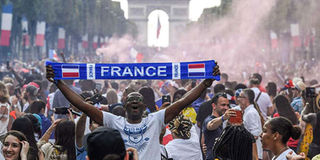Paris's emblematic Champs Elysees, place of jubilation

A man holds up a French supporter scarf on the Champs-Elysees avenue in Paris on July 15, 2018 during their Russia 2018 World Cup final match against Croatia. PHOTO | ERIC FEFERBERG |
What you need to know:
- On Bastille Day in 2002, president Jacques Chirac survived an assassination attempt on the avenue by a right wing extremist who fired off one shot from a rifle hidden in a guitar case before bystanders wrestled him to the ground.
- And in April 2017 a man claiming allegiance to the jihadist Islamic State group shot and killed a police officer on the avenue.
PARIS
The Champs Elysees avenue is the beating heart of Paris, a magnet for millions of tourists but also a place of mass gathering when the French want to celebrate.
The emblematic avenue rapidly filled to capacity on Sunday as Parisians revelled in France's second World Cup victory. More than a million people invaded the broad thoroughfare on July 12, 1998, after France clinched the trophy on home soil.
The next day the world champions were driven down the avenue in a double-decker bus, although the crowds prevented them from going right up to the famous Arc de Triomphe.
Elegant city stage
As cherished by tourists as the Eiffel Tower just across the River Seine, the elegant avenue stretching for two kilometres (more than a mile) from the Arc de Triomphe down to Concorde Square was first laid out in 1670.
Tens of thousands of people daily throng the tree-lined artery which is home to luxury boutiques, chain stores, cafes, cinemas and high-end offices.
The Obelisk of Luxor at Concorde Square, the Tuileries Garden and the Louvre Museum are all visible from what is dubbed "the most beautiful avenue in the world".
Every year it hosts major popular events like the traditional military parade on July 14, the Bastille Day national holiday — which this year fell on the eve of the World Cup triumph.
The Champs Elysees is also the finish line for the world's toughest cycling race, the Tour de France, and hundreds of thousands of Parisians and tourists gather there to see in the New Year.
A role in history
Once fields and fallow land, the avenue started to take shape when Louis XIV's city planner Jean-Baptiste Colbert first linked the Louvre to the Tuileries Garden in the mid-17th century.
The name is French for Elysian Fields, the paradise for dead heroes in Greek mythology.
During the French Revolution in 1789 an angry mob set off from the avenue to march on Versailles, Louis XVI's opulent retreat.
Four years later he would be guillotined at the Place de la Revolution, which would be renamed Concorde after the July Revolution of 1830.
After Napoleon I elected to have the Arc de Triomphe built at the avenue's apex to celebrate his military successes, Baron Haussmann, architect of the transformation of Paris under Napoleon III, effected a stylish revamp.
French soldiers paraded there for the first time in July 1915 and it was also the site chosen by General Charles de Gaulle to celebrate the August 25, 1944, liberation of Paris from Nazi Germany.
Inspirational
The mythic avenue has been the subject of songs and films, inspiring Jean-Luc Godard's legendary new wave film "A Bout de Souffle" ("Breathless") in 1960.
Among the rich and famous who have lived on the Champs Elysees are French actress Sarah Bernhardt, US president Thomas Jefferson and French president Raymond Poincare.
Scene of attacks
The internationally known landmark as also been the scene of modern-day attacks.
On Bastille Day in 2002, president Jacques Chirac survived an assassination attempt on the avenue by a right wing extremist who fired off one shot from a rifle hidden in a guitar case before bystanders wrestled him to the ground.
And in April 2017 a man claiming allegiance to the jihadist Islamic State group shot and killed a police officer on the avenue.





